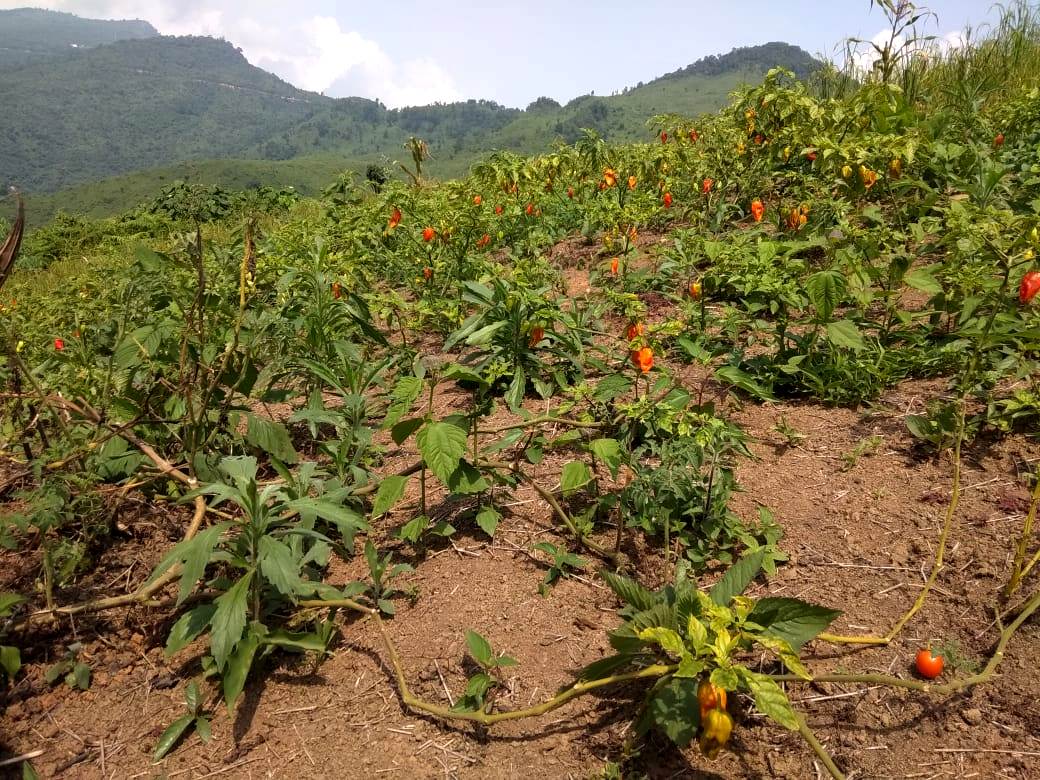
- A
Naga King Chilli farm owned by Ipungba Cerai in Old Tesen village, Peren
district.
- DIMAPUR — Every
year, as summer approaches, markets across Nagaland burst into fiery red with
mounds of Naga King Chilli—a globally recognised and locally relished spice.
- Certified by the Guinness World Records in 2006 for its heat
and awarded a Geographical Indication (GI) tag in 2008, this chilli has long
been a point of pride for the state.
- However, an increasing influx of similar-looking chillies
from Arunachal Pradesh and Assam is posing a serious challenge to local
farmers.
- Currently, markets in Dimapur and Kohima are flooded with
King Chilli, but much of it, according to vendors, is sourced from neighbouring
states.

A Naga King Chilli vendor waits for customers at a market
in Dimapur.
- The authentic Raja Mircha from Nagaland typically enters the
market around July and is available until October or November.
- Yet, in April itself, chillies sold in markets are being
labelled as King Chilli, with most vendors claiming they are from Arunachal
Pradesh or Assam—available at much lower prices ranging from INR 200 to INR 250
per kg.
- In contrast, the Nagaland-grown variety usually fetches
between INR 400 and INR 500 per kg at peak season.
- A visit to the markets here reveals that these chillies are
transported daily by night buses, and vendors often buy them in bulk—20 to 30
kilograms per delivery.
- One of the vendors said that they make the purchase at INR
200 for one kilo.
Also read: A Week in Dimapur-Chumoukedima Markets: From Monday to Saturday
- On May 17, the Dimapur Municipal Council’s price chart
confirmed a retail price of INR 410 per kg for King Chilli; the wholesale rate
was pegged at INR 350 per kg.
- Interestingly, Ipungba Cerai, a seasoned farmer from Old
Tesen in Peren district, shared that he supplies to Arunachal Pradesh, Manipur
and Assam, although not on a regular basis.
- Primarily, his chillies are meant for the local market.
- He also disclosed exporting King Chilli to Hong Kong and the
Maldives once.
- According to him, planting begins in March, and the crop is
harvested between July and August.
- Depending on the yield, prices can range from INR 180 to as
high as INR 800 per kg.
- Weekly supplies to Dimapur can amount to 1,000 kilograms, which
can earn a farmer at least INR 1.8 lakh per week, even at lower prices.
- Cerai acknowledged that while King Chilli farming is
lucrative, its perishable nature makes it difficult to meet interstate demands
unless the produce is dried or frozen.
- The cost of transportation and risk of spoilage are other
deterrents for local farmers.
- He also contested the vendors' claims, suggesting that many
falsely label Assam-grown chillies as Arunachal produce to avoid customer
concerns over the use of artificial fertilisers.
- But he also clarified that unless lab-tested, it’s
impossible to verify whether chemical fertilisers are used or not.
- According to him, one of the key issues farmers face is lack
of access to food dehydrator machines, which would allow them to preserve large
quantities of fresh chillies and meet market demands beyond the harvest window.
- Neizonuo Thevo, another King Chilli farmer from Seiyhama
village and an organiser of the annual ‘Organic King Chilli Festival’, noted
that their produce rarely leaves Kohima district due to high local demand.
- In her village, chillies are sold either per kilogram (INR
350–400) or per tin (3–3.5 kg) at INR 1,500.
- Buyers, often non-Nagas, collect large quantities—up to 120
tins at a time—directly from the village.
- Like many in her community, Thevo maintained that King
Chilli is a supplementary income, with farmers also cultivating other crops.
- While they rarely suffer losses, occasional poor yields are
attributed to factors like plant disease or improper growth conditions.
- Supporting the views of local farmers is Senti Longchar, a
District Horticulture Officer (DHO) from Kiphire, who has spent nearly a decade
studying the crop.
- Longchar is also the composer of the tribute song
“Chaiberachi”, released ten years ago in honour of King Chilli farmers.
- His fascination with the chilli stems from its unique aroma,
vibrant colour, and specific environmental needs. “It doesn’t grow randomly
like other crops. It requires semi-shade, a moderate climate, rich soil, and
proper nutrition,” he explained.
- Longchar rejected claims that other states produce more or
spicier chillies, stating that such assumptions can only be verified through
scientific testing using the Scoville Heat Unit (SHU) method at laboratories
like the Central Food Technological Research Institute (CFTRI) in Mysuru.
- He also revealed that years ago, he had trained farmers in
Arunachal Pradesh and Meghalaya on King Chilli cultivation techniques, which
may explain the growing supply from those states.
- However, he maintained that Nagaland’s production remains
higher.
- According to him, King Chilli farming in Nagaland is most
prevalent in Peren, Mon, and Kohima districts.
- Yet, many farmers do not follow best agricultural practices,
which can result in lower yields.
- “For sustainable and profitable farming, they must adopt
basic steps like proper soil preparation, manuring, sowing techniques, and
ensuring partial shade. These small changes can greatly improve yield,” he
maintained.
- Despite the increasing market competition and logistical
challenges, he was optimistic that with the right infrastructure and farmer
support, Naga King Chilli can continue to thrive, maintaining its identity as
not just a spice but as an economic lifeline for many.
Read more: Aliba’s cucumbers fulfil Nagaland government’s ‘One Village, One Product’ vision—Minister Temjen Imna Along

